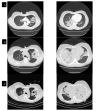Necrotizing Pneumonia: A Practical Guide for the Clinician
- PMID: 39599537
- PMCID: PMC11597800
- DOI: 10.3390/pathogens13110984
Necrotizing Pneumonia: A Practical Guide for the Clinician
Abstract
While rare, necrotizing pneumonia is a severe and potentially life-threatening manifestation of lung parenchyma infection. Initially documented in the 1940s, it was a significant contributor to mortality rates in both adults and children, with figures reaching up to 45%. Despite being a disease described in the literature for decades, data on the management of necrotizing pneumonia remain limited. Most available information comes from retrospective observational cohort studies. This article aims to provide a comprehensive summary of the existing literature on the subject.
Keywords: necrotizing pneumonia; pulmonary gangrene; sepsis; septic emboli.
Conflict of interest statement
The authors declare no conflicts of interest.
Figures





Similar articles
-
Pediatric Necrotizing Pneumonia: A Case Report and Review of the Literature.Pediatr Emerg Care. 2017 Feb;33(2):112-115. doi: 10.1097/PEC.0000000000000585. Pediatr Emerg Care. 2017. PMID: 26785088 Review.
-
Surgical therapy for necrotizing pneumonia and lung gangrene.Thorac Cardiovasc Surg. 2013 Oct;61(7):636-41. doi: 10.1055/s-0032-1311551. Epub 2012 Oct 3. Thorac Cardiovasc Surg. 2013. PMID: 23034873
-
Unusual case of necrotizing pneumonia caused by Fusobacterium nucleatum complicating influenza a virus infection.Anaerobe. 2021 Jun;69:102342. doi: 10.1016/j.anaerobe.2021.102342. Epub 2021 Feb 7. Anaerobe. 2021. PMID: 33567343
-
Management of necrotizing pneumonia and pulmonary gangrene: a case series and review of the literature.Can Respir J. 2014 Jul-Aug;21(4):239-45. doi: 10.1155/2014/864159. Epub 2014 May 2. Can Respir J. 2014. PMID: 24791253 Free PMC article. Review.
-
A challenging high-risk surgery for necrotizing pneumonia in a right bilobed lung.BMC Pediatr. 2023 Apr 13;23(1):170. doi: 10.1186/s12887-023-03999-y. BMC Pediatr. 2023. PMID: 37046243 Free PMC article.
Cited by
-
Fulminant Methicillin-Sensitive Staphylococcus aureus Pneumonia in a Steroid-Treated Patient With End-Stage Renal Disease: A Rapidly Fatal Case.Cureus. 2025 May 15;17(5):e84155. doi: 10.7759/cureus.84155. eCollection 2025 May. Cureus. 2025. PMID: 40525013 Free PMC article.
-
Necrotizing Pneumonia as a Complication of Community-Acquired Pneumonia in Adults at a Tertiary Institution.J Clin Med. 2025 Jun 10;14(12):4086. doi: 10.3390/jcm14124086. J Clin Med. 2025. PMID: 40565832 Free PMC article.
-
Community-Acquired Necrotizing Pneumonia with Bronchopleural Fistulas Due to Streptococcus pneumoniae in an Adult.Infect Drug Resist. 2025 Apr 12;18:1831-1836. doi: 10.2147/IDR.S511714. eCollection 2025. Infect Drug Resist. 2025. PMID: 40242389 Free PMC article.
-
Necrotizing Pneumonia Mimicking Lung Tumour: A Case Report.Respirol Case Rep. 2025 Jul 8;13(7):e70264. doi: 10.1002/rcr2.70264. eCollection 2025 Jul. Respirol Case Rep. 2025. PMID: 40636935 Free PMC article.
-
Modified thoracostomy window as a surgical treatment for chronic pleuropulmonary infections.J Thorac Dis. 2025 Jun 30;17(6):3853-3862. doi: 10.21037/jtd-2025-238. Epub 2025 Jun 18. J Thorac Dis. 2025. PMID: 40688330 Free PMC article.
References
Publication types
MeSH terms
Substances
LinkOut - more resources
Full Text Sources

